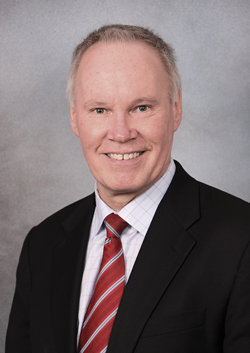A Technical Edge in Law
 Like many, Scott Lindvall’s journey to law school didn’t follow a direct course. He began his work life as an aerospace engineer.
Like many, Scott Lindvall’s journey to law school didn’t follow a direct course. He began his work life as an aerospace engineer.
“After graduating from Virginia Tech in 1980 with a degree in aerospace engineering, I moved to St. Louis to design F-18 fighter jets for McDonnell Douglas,” Lindvall says.
During his three years in St. Louis, he worked on a research project to compute airflow over an object, and earned his master’s degree in mechanical engineering from Washington University. After several years, he felt ready for a new challenge, and began to serve as an expert witness for aircraft crash investigations.
“As I worked with lawyers to reconstruct aircraft accidents, I found that many attorneys lacked the technical background to understand the details,” Lindvall says. “I realized it would be really useful to have a lawyer with engineering training in these cases, so I decided to go to law school.”
After considering a number of schools, he found William & Mary to be the perfect fit. “From my first visit, the school had a warm and friendly atmosphere which I didn’t find elsewhere,” he recalls. “The smaller size and comfortable learning environment allowed me to thrive.”
Although he would go on to serve as editor of the William & Mary Law Review, Lindvall had some initial moments of doubt as he made the transition from engineer to law student.
“I was concerned I wouldn’t be able to write and think like others from a non-technical field. My world was math and formulas,” he says. “When I got a ‘high pass’ on my first legal writing assignment, I was shocked; and I knew I had made the right choice. Going to William & Mary turned out to be the best decision I ever made.”
After graduation, Lindvall took a position in the Washington, D.C., office of Morgan, Lewis & Bockius where he combined technical and legal skills to work on government contracts and intellectual property. In 1994, he moved to New York City to work in patent litigation at Kaye Scholer.
Today he routinely combines his dual expertise as counsel in patent infringement cases for clients ranging from major pharmaceutical companies to Rolls-Royce (jet engines) and Nintendo.
“Every case is different, with different technologies, different people, and different issues,” Lindvall says. “But I am able to tap into my background, which has been invaluable, especially when I’m trying to get a jury to understand tough technology concepts and disputes. William & Mary did a great job of preparing me to do this kind of work.”
Several years ago, Lindvall was asked to become a trustee of The Marshall-Wythe School of Law Foundation.
“I was honored to join the board,” he says. “Now more than ever, all schools need alums to come forward and help. I believe that if your school helped you to be successful, you should give back.”
Lindvall sometimes meets with students who are looking for ways to make the most of their time in law school. His advice is to take courses in areas they won’t necessarily be immersed in at the start of their careers. Lindvall feels that, in his own case, classes in corporations and antitrust law helped round out his knowledge.
“I have been watching how William & Mary has grown and progressed over the years and I’m impressed. As the school continues to get better and better, it hasn’t lost that warm feeling that was so important when I was there.”
About William & Mary Law School
Thomas Jefferson founded William & Mary Law School in 1779 to train leaders for the new nation. Now in its third century, America's oldest law school continues its historic mission of educating citizen lawyers who are prepared both to lead and to serve.